项目地址: ruby-prof
在上一篇Ruby中的Profiling工具中,我们列举了几种 最常用的Profiler,不过只是简单介绍,这一次详细介绍一下ruby-prof的使用方法。
ruby-prof是比较强大的,支持cpu,内存使用,对象分配等等的性能分析,而且提供了很多友好的输出格式,不仅仅是
有基于文字,html的格式,还能输出graphviz格式的dot文件,以及适用与KCacheGrind的call tree格式,
其实这个格式是基于Valgrind的,这个工具很棒,大家可以去官网了解一下。
有两种方式运行ruby-prof,一种是需要在源码中插入ruby-prof的启动和停止代码:
require 'ruby-prof'
RubyProf.start
# 这里写入要进行性能剖析的代码
result = RubyProf.stop
# 选择一个Printer
printer = RubyProf::FlatPrinter.new(result)
printer.print(STDOUT)
还有一种是在命令行直接运行的,安装了Gem包ruby-prof之后,会同时安装ruby-prof命令,使用如下:
ruby-prof -p flat test.rb
这种方法更灵活,我们使用这种方法来说明ruby-prof的使用方法。
直接运行ruby-prof -h得到ruby-prof的帮助信息,由于太多,这里就不列出来了,大家可以自己在系统中执行看看。
其中-p参数为输出格式,以下就会逐一介绍各个Printer的格式,指数的意义以及相关显示工具的使用。在介绍输出格式的过程中,也会相应的介绍其他的几个参数的用途。
输出格式类型
flat - Prints a flat profile as text (default).
flat_with_line_numbers - same as flat, with line numbers.
graph - Prints a graph profile as text.
graph_html - Prints a graph profile as html.
call_tree - format for KCacheGrind
call_stack - prints a HTML visualization of the call tree
dot - Prints a graph profile as a dot file
multi - Creates several reports in output directory
示例程序
def m1
"string" * 1000
end
def m2
"string" * 10000
end
def start
n = 0
n = n + 1 while n < 100_000
10000.times do
m1
m2
end
end
start
这是最基础的测试程序,我们会在介绍ruby-prof的功能的同时添加其他代码来进行演示。
GC对性能剖析的影响
进行性能剖析的时候GC的运行总会对结果产生比较大的影响,这里我们暂时不考虑它,我们会有另外一篇文章 做专门的介绍。
最简单的输出格式 - flat
ruby-prof -p flat test.rb
Measure Mode: wall_time
Thread ID: 12161840
Fiber ID: 19223800
Total: 0.206998
Sort by: self_time
%self total self wait child calls name
68.50 0.142 0.142 0.000 0.000 20000 String#*
10.45 0.207 0.022 0.000 0.185 1 Object#start
6.82 0.014 0.014 0.000 0.000 100001 Fixnum#<
6.46 0.013 0.013 0.000 0.000 100000 Fixnum#+
2.84 0.158 0.006 0.000 0.152 1 Integer#times
2.52 0.128 0.005 0.000 0.123 10000 Object#m2
2.40 0.024 0.005 0.000 0.019 10000 Object#m1
0.01 0.207 0.000 0.000 0.207 2 Global#[No method]
0.01 0.000 0.000 0.000 0.000 2 IO#set_encoding
0.00 0.000 0.000 0.000 0.000 3 Module#method_added
* indicates recursively called methods
先来一一解释一下各项指标的意思:
| Indicator | Explanation |
|---|---|
| %self | 方法本身执行的时间占比,不包括调用的其他的方法执行时间 |
| total | 方法执行的总时间,包括调用的其他方法的执行时间 |
| self | 方法本身执行的时间,不包括调用的其他的方法执行时间 |
| wait | 多线程中,等待其他线程的时间,在单线程程序中,始终为0 |
| child | 方法调用的其他方法的总时间 |
| calls | 方法的调用次数 |
他们之间的基本关系就是:
total = self + wait + child
具体来说就是String#*这个方法占据程序运行时间的68.50%,花费了0.142秒,执行了20000次,而
Object#start方法就是代码中定义的start方法,它占据程序运行时间的10.45%,花费了0.022秒,调用的
方法花费了0.185秒,调用了1次,总共花费的时间(total)为0.022 + 0.185 = 0.207,相信现在大家都能明
白这些指数的意义了。
现在我们明白了这个输出的指标意思,假如这个程序是存在性能问题的,那么这些数据说明了什么问题?通常情况下,
我们需要看两个指标,%self和calls,单纯看%self有时候是没有用的,上面这个例子,它的耗时方法是String#*,
我们不太可能去改进语言本身的方法,这种情况下,我们发现calls的值比较大,那么就想办法减少对String#*的方法调用。
利用flat输出格式,也就只能发现这样简单的问题,如果这时候想要减少String#*的方法调用,就需要知道是谁调用了它,
而这个输出格式是体现不出来的,就需要选择其他的输出格式。
简单的调用关系输出 - graph
ruby-prof -p graph test.rb
Measure Mode: wall_time
Thread ID: 17371960
Fiber ID: 24397420
Total Time: 0.21026015281677246
Sort by: total_time
%total %self total self wait child calls Name
--------------------------------------------------------------------------------
99.99% 0.01% 0.210 0.000 0.000 0.210 2 Global#[No method]
0.210 0.022 0.000 0.188 1/1 Object#start
0.000 0.000 0.000 0.000 3/3 Module#method_added
--------------------------------------------------------------------------------
0.210 0.022 0.000 0.188 1/1 Global#[No method]
99.98% 10.34% 0.210 0.022 0.000 0.188 1 Object#start
0.161 0.006 0.000 0.155 1/1 Integer#times
0.014 0.014 0.000 0.000 100001/100001 Fixnum#<
0.014 0.014 0.000 0.000 100000/100000 Fixnum#+
--------------------------------------------------------------------------------
0.161 0.006 0.000 0.155 1/1 Object#start
76.48% 2.68% 0.161 0.006 0.000 0.155 1 Integer#times
0.130 0.005 0.000 0.125 10000/10000 Object#m2
0.025 0.005 0.000 0.020 10000/10000 Object#m1
--------------------------------------------------------------------------------
0.020 0.020 0.000 0.000 10000/20000 Object#m1
0.125 0.125 0.000 0.000 10000/20000 Object#m2
69.23% 69.23% 0.146 0.146 0.000 0.000 20000 String#*
--------------------------------------------------------------------------------
0.130 0.005 0.000 0.125 10000/10000 Integer#times
61.81% 2.28% 0.130 0.005 0.000 0.125 10000 Object#m2
0.125 0.125 0.000 0.000 10000/20000 String#*
--------------------------------------------------------------------------------
0.025 0.005 0.000 0.020 10000/10000 Integer#times
11.99% 2.28% 0.025 0.005 0.000 0.020 10000 Object#m1
0.020 0.020 0.000 0.000 10000/20000 String#*
--------------------------------------------------------------------------------
0.014 0.014 0.000 0.000 100001/100001 Object#start
6.73% 6.73% 0.014 0.014 0.000 0.000 100001 Fixnum#<
--------------------------------------------------------------------------------
0.014 0.014 0.000 0.000 100000/100000 Object#start
6.42% 6.42% 0.014 0.014 0.000 0.000 100000 Fixnum#+
--------------------------------------------------------------------------------
0.01% 0.01% 0.000 0.000 0.000 0.000 2 IO#set_encoding
--------------------------------------------------------------------------------
0.000 0.000 0.000 0.000 3/3 Global#[No method]
0.00% 0.00% 0.000 0.000 0.000 0.000 3 Module#method_added
* indicates recursively called methods
这次输出的内容就比较丰富,不过也可能让人头有点晕。我们来慢慢分析一下。
首先这次排序方式不一样了,是按照total_time排序的,flat输出格式是按照self_time排序的。整个报告被虚线分割为
几部分,每部分中都描述了不定个数的方法调用信息,但是注意最左边两列,就是%total, %self那两列不为空的那一行,
先来看第二部分:
--------------------------------------------------------------------------------
0.210 0.022 0.000 0.188 1/1 Global#[No method]
99.98% 10.34% 0.210 0.022 0.000 0.188 1 Object#start
0.161 0.006 0.000 0.155 1/1 Integer#times
0.014 0.014 0.000 0.000 100001/100001 Fixnum#<
0.014 0.014 0.000 0.000 100000/100000 Fixnum#+
--------------------------------------------------------------------------------
Object#start方法的执行花费了99.98%的总时间,不包括子方法调用的话,花费了10.34%的时间,调用了
一次,并且在start方法中还调用了Integer#times、Fixnum#<和Fixnum#+三个方法。
再来看右数第二列(calls),是被/分隔的两个数,左边的数是此方法在这一层级调用了多少次Object#start,右边的数是
Object#start这个程序运行过程中总的运行次数。而Object#start调用的三个方法calls列出的是在Object#start
中执行的次数,以及总的执行次数。
最开始的一部分中有这样两个方法:Global#[No method]代表没有caller,可以理解为ruby正在准备执行环境,
Module#method_added是当有实例方法添加的时候,这个方法都会被触发。
那么这种输出格式能解释什么问题呢?在flat输出格式中我们已经定位到了问题是String#*的调用次数太多,
那么根据这个graph格式的输出格式我们应该可以找到是谁导致的这个问题。
先把可以发现问题的部分截出来:
--------------------------------------------------------------------------------
0.020 0.020 0.000 0.000 10000/20000 Object#m1
0.125 0.125 0.000 0.000 10000/20000 Object#m2
69.23% 69.23% 0.146 0.146 0.000 0.000 20000 String#*
--------------------------------------------------------------------------------
0.130 0.005 0.000 0.125 10000/10000 Integer#times
61.81% 2.28% 0.130 0.005 0.000 0.125 10000 Object#m2
0.125 0.125 0.000 0.000 10000/20000 String#*
--------------------------------------------------------------------------------
0.025 0.005 0.000 0.020 10000/10000 Integer#times
11.99% 2.28% 0.025 0.005 0.000 0.020 10000 Object#m1
0.020 0.020 0.000 0.000 10000/20000 String#*
--------------------------------------------------------------------------------
第一部分说明String#*在Object#m1和Object#m1中各被调用了10000次,一共执行了20000次,次数一样,接着看下面,
同样是10000次,在Object#m2中花费的时间是0.125秒,而在Object#m1中花费的时间是0.020秒,多出了0.105秒,这样,
我们能定位出问题出在了Object#m2这里。
graph可输出为html格式,这里只是演示了纯文本版,html格式更容易交互,需要添加参数-f指定输出的路径和文件名。
GraphViz dot - dot
ruby-prof -p dot test.rb -f dot.dot
有工具可以将dot文件转换为pdf查看,也有专门查看dot文件的工具,比如ubuntu上的XDot。
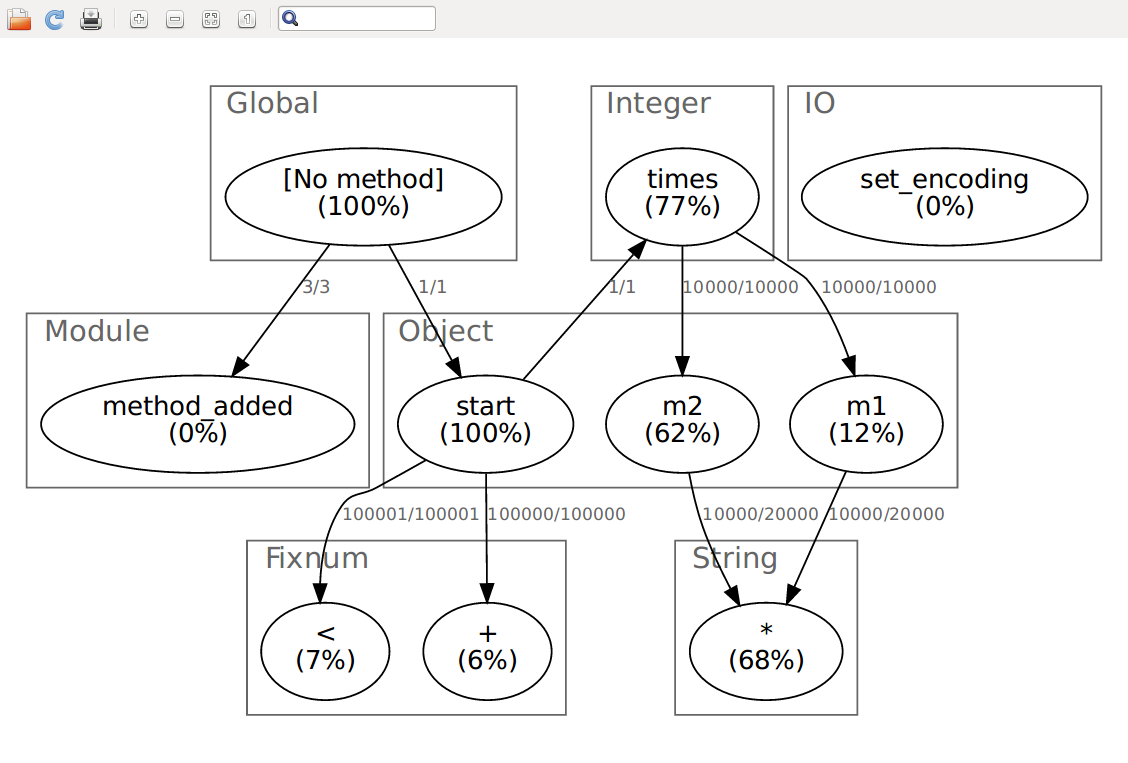
这张图也明确说明了问题出在了Object#m2这里。
可交互的调用关系 - call_stack
ruby-prof -p call_stack test.rb -f callstack.html

这里真是一图胜千言,一目了然,Object#m2中的String#*的10000次调用花费了60.52%的时间,不用多解释,快点自己尝试一下吧。
终极万能全视角 - call_tree
首先安装KCacheGrind,ubuntu下直接'sudo apt-get install kcachegrind'
ruby-prof -p call_tree test.rb -f call_tree.out
打开KCacheGrind,然后打开call_tree.out(文件类型选所有),这个神奇的工具能呈现给你所有真相。
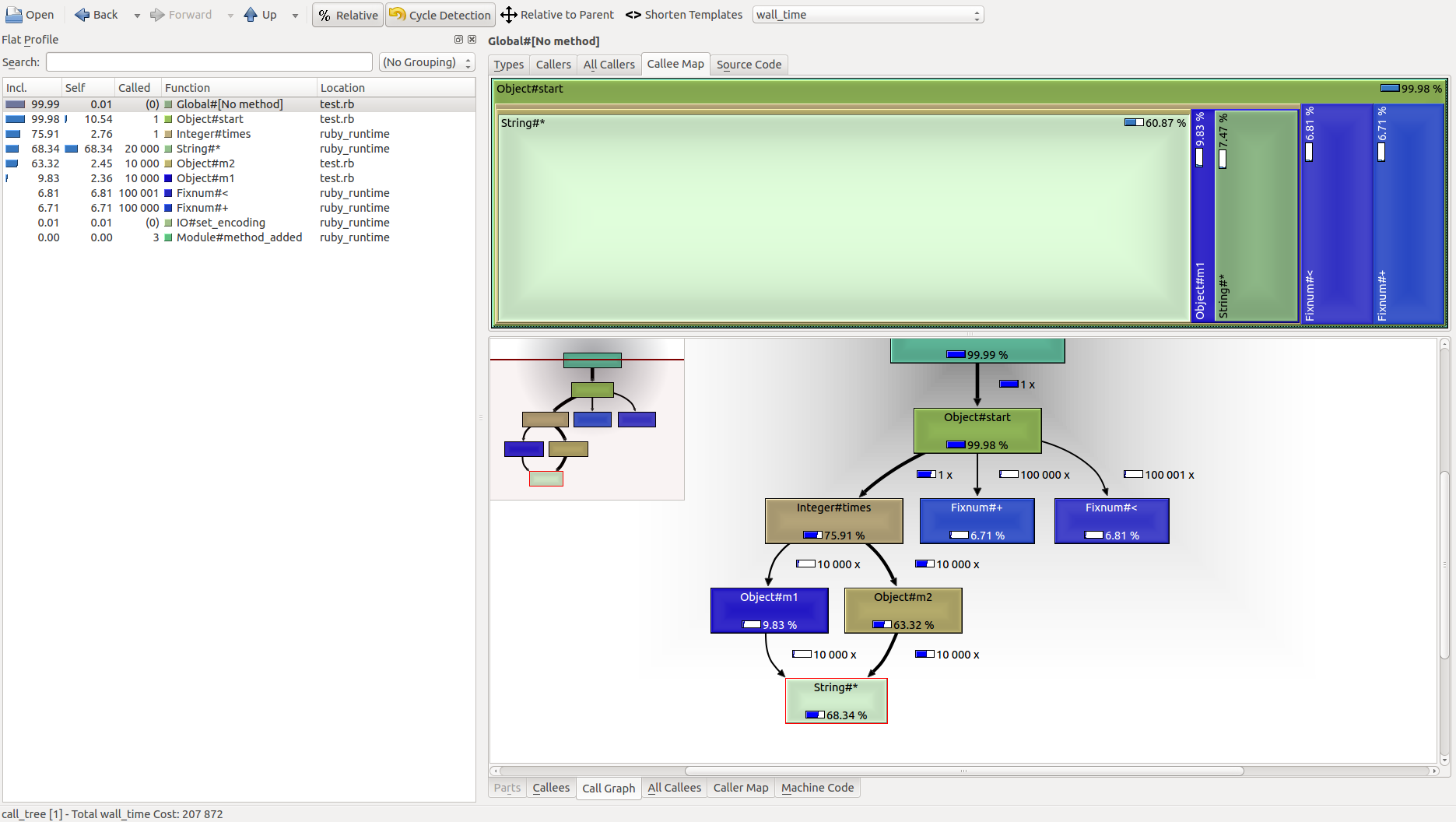
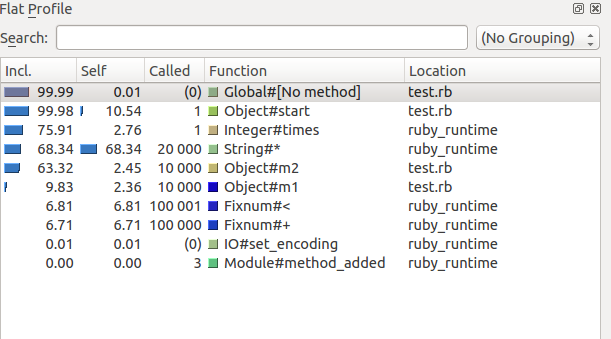

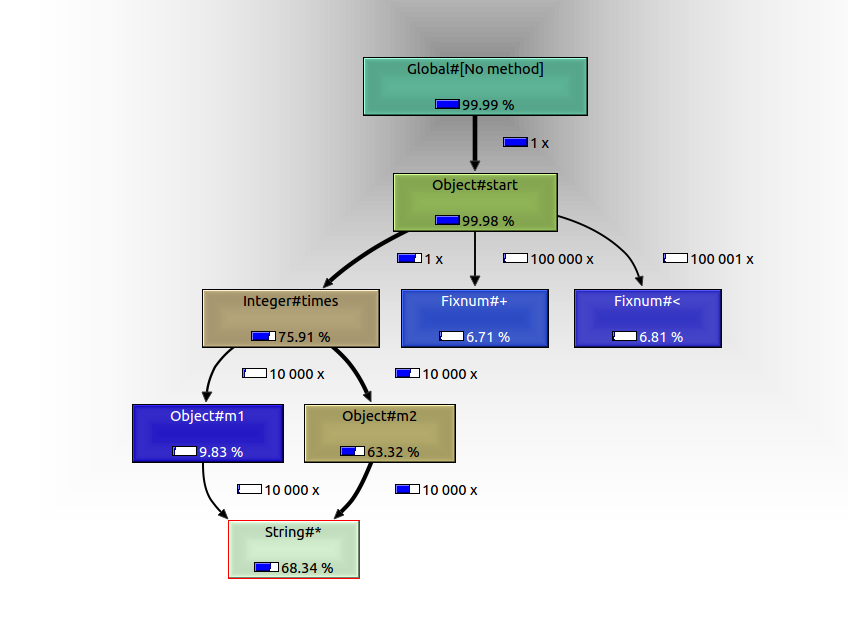
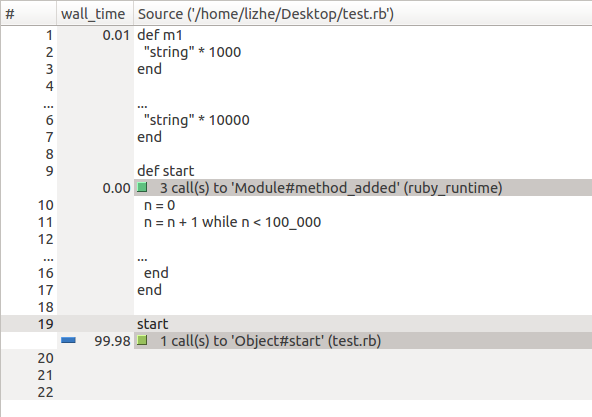
有了前面介绍的输出格式说明,看懂这个就很容易了,我们还是会介绍一下,不过是在另一篇,因为这篇有点太长了,下一篇 会详细介绍一下KCacheGrind的使用方法。